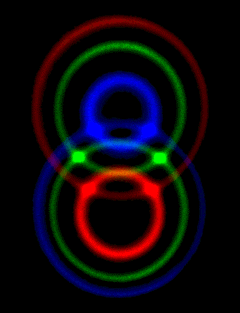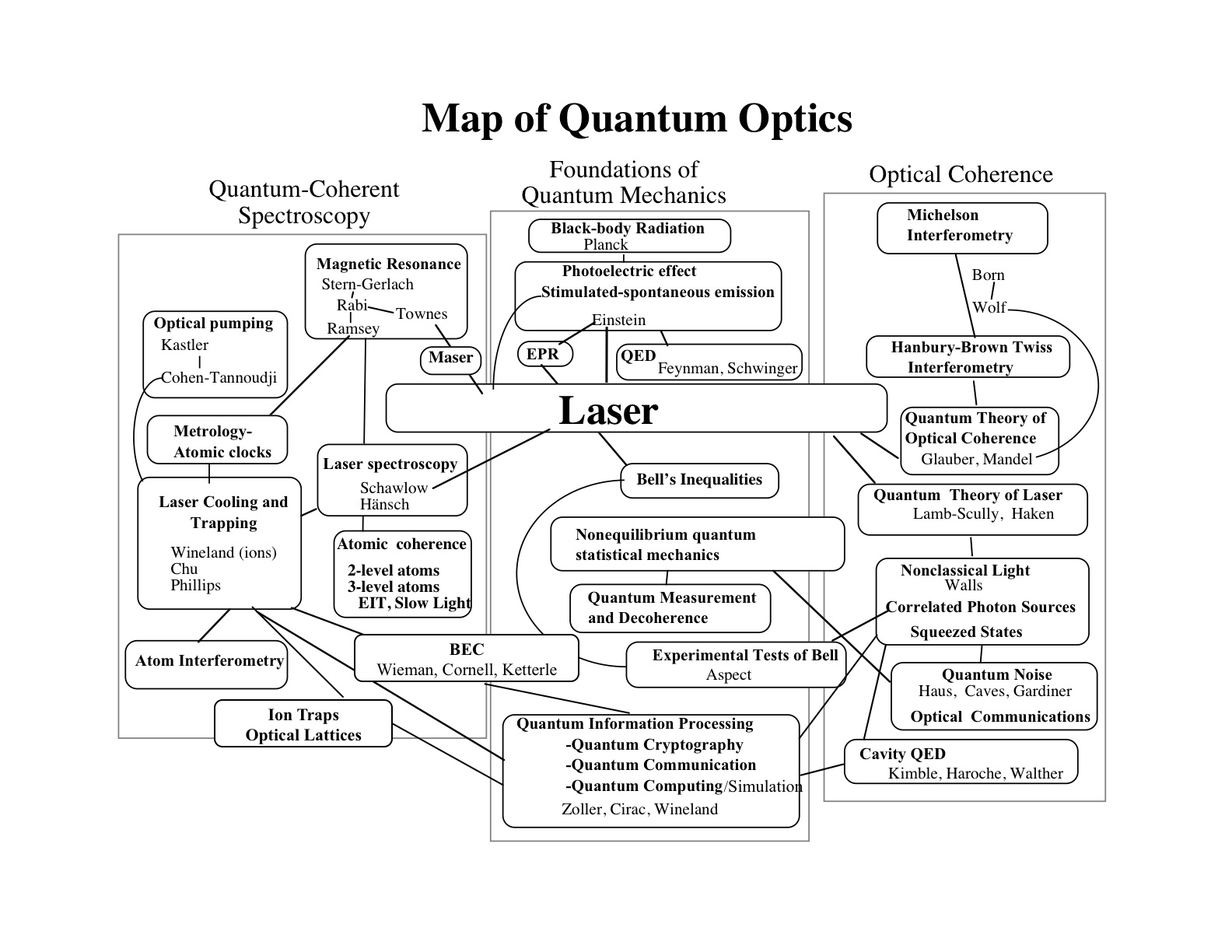

Office Hours: Wed. 10:00-11:00, Room 23
Problem Session: Mon. 2:00-3:00, Room 5

Quantum Optics map (pdf download)
"Recommended" Texts (none required):
* Atom-Photon interactions- Cohen-Tannoudji,
* Quantum Optics - Scully and Zubairy,
* Quantum Optics, by R. Y. Chiao and J. C. Garrision
We will not be following any of these texts directly . They all have strengths in different areas and are good to have on your bookshelf.
Other Texts:
Recent books (published within the last 5 years)
* Statistical Methods in Quantum Optics 1 and 2, by H. J. Carmichael
* Quantum Noise, by C. Gardiner (also Handbook of Stochastic Methods)
* Quantum Optics, An Introduction, by M. Fox
* Introductory Quantum Optics by C. Gerry and P. Knight
* Fundamental of Quantum Optics, by J. R. Klauder and E. C. G. Sudarshan
* Quantum Optics: Including Noise Reduction, Trapped Ions, Quantum Trajectories, and Decoherence by M. Orszag
* Introduction to Quantum Optics: From Light Quanta to Quantum Teleportation by H. Paul and I. Jex
* Fundamentals of Quantum Optics and Quantum Information by P. Lambropoulos and D. Petrosyan
* Modern Foundations Of Quantum Optics by Vlatko Vedral
Older standards
* Elements of Quantum Optics, by P. Meystre and M. Sargent
"Quantum Optics" - Walls and Milburn
* Photons and Atoms: Introduction to Quantum Electrodynamics, by Claude Cohen-Tannoudji et al.
* Optical Coherence and Quantum Optics, by L. Mandel and E. Wolf
* Lasers, by P. Milonni and J. H. Eberly
* Optical Resonance and Two-Level Atoms , by Allen and J. H. Eberly
* Quantum Statistical Properties of Radiation, by W. H. Louisell
* Quantum Properties or Radiation, R. Loudon
* Laser Theory, by H. Haken
Grading:
* Problem Sets (8-10 assignments) 50%
* Midterm 25%
* Final Project 25%
* Problem sets will be available on the web, about every week. Generally assignments will be due in class, Tuesdays.
Phys. 566: Quantum Optics I
I. Classical foundations
A. Oscillators, interference, and coherence.
B. Simple
harmonic oscillators, quadratures, and Fourier analysis.
C. Lorentz
oscillator model.
II. Quantum foundations
A. Density matrix and coherence.
B. Two level
systems -- Pauli algebra, Bloch-sphere, magnetic resonance.
C. Quantum
simple harmonic oscillator.
III. Optical resonance for two level atoms
A. Atom-photon interaction in electric dipole approximation.
B.
Pseudo-spin formulation, Rabi flopping.
C. Density
matrix formulation.
D.
Phenomenological damping -- master equation and rate equations.
IV. The electromagnetic vacuum
A. Quantization of the electromagnetic field.
B.
Spontaneous emission and Wigner-Weisskopf theory.
C. Resonance
fluorescence -- Mollow triplet.
D. Jaynes-Cummings model -- Dressed states.
V. Three level quantum coherence
A. Raman resonance.
B. Dark
states and EIT.
C. Slow
light, fast light, and polaratons.
VI. Quantum-Optical Coherence
A. Photon counting statistics -- Mandel's formula.
B. Theory of
partial coherence - Classical statistical optics
C. Coherent states as quasi-classical states.
D. Glauber's correlation functions.
E. Hanbury-Brown and Twiss interferometry.
F. Bunching, antibunching ,and photon statistics.
Phys. 581: Quantum Optics II
I. Nonclassical Light
A. Phase space methods -- Quasiprobability distributions, P-Glauber, Q-Husimi,
W-Wigner functions.
B. Nonlinear
optics and nonclassical light.
C. Squeezed
states.
D. Homodyne
detection.
E.
Correlated twin photons.
F. Photon interferometry.
II. Foundations
A. Bipartite entanglement.
B. EPR and
Bell’s Inequalities, finite and infinite dimensional systems.
C.
Completely-positive map, Kraus operators, and POVMs.
III. Open quantum systems
A. System-reservoir interactions.
B. Born-Markoff approximation and the Lindblad Master Equation.
C.
Phase-space representation: Fokker-Planck equation.
D.
Heisenberg-Langevin equation.
III. Continuous measurement
A. Quantum trajectories – different unravelings of the Master Equation.
B. Quantum Monte-Carlo wave functions.
C. The
stochastic Schrödinger equation.
D. Quantum
filtering theory.
IV. Fundamental Paradigms of quantum optics
A. Cavity QED (from atoms to superconductors)
B. Ion
traps.
C. Cold
neutral atom ensembles.
D.
Correlated photons and squeezed states.
V. Applications in quantum information processing
A. Quantum communication
B. Quantum
computation
C. Quantum
metrology
Aug. 20
|
Overview of Class.
Quantum and Classical Coherence
|
|
Aug. 22
|
Oscillators, Quadratures, and Fourier Analysis
|
|
Aug. 27
|
Lorentz Oscillator Model
|
|
Aug. 29
|
Lorentz Oscillator Model Continued: Radiation Reaction and the Classical Theory of Resonance Fluorescence
|
|
Sep. 3
|
Two level atoms -- Paul algebra, Bloch-sphere, SU(2)
|
|
Sep. 5
|
Continuation
|
|
Sep. 10
|
Magnetic Resonance - Rabi flopping
|
|
Sep. 12
|
Continuation
|
|
Sep. 17
|
Laser spectroscopy as magnetic resonance Coherence and the Density Matrix
|
|
Sep. 19
|
Continuation
|
|
Sep. 24
|
Optical Bloch Equations (I) Phenomenological decay T1 and T2
|
|
Sep. 26
|
Continuation
|
|
Oct. 1
|
Optical Bloch Equations (II) Two-level atom damped response
|
|
Oct. 3
|
Three-level atoms: Adiabatic elimination
|
|
Oct. 8
|
Dressed States and Raman Transitions |
|
Oct. 10
|
Fall Break |
|
Oct.15
|
Dark states, Coherent Population Trapping, Electromagnetically Induced Transparency |
|
Oct. 17
|
Introduction to Quantum Field Theory |
|
Oct. 22
|
Continuation |
|
Oct. 24
|
Midterm Exam |
|
Oct. 29
|
Quantization of the electromagnetic field |
|
Oct. 31
|
Introduction to Quantize Field - Atom Interactions The Jaynes-Cummings Model |
|
Nov. 5
|
Continuation
|
|
Nov. 7
|
Spontaneous emission: Wigner-Weisskopf |
|
Nov. 12
|
Wigner-Weisskopf 2: Schrödinger picture: Single photon spontaneous wavepackets Heisenberg picture: Radiation reaction vs. vacuum fluctations
|
|
Nov. 14
|
Photon counting experiments and photon statistics Coherent states as quasiclassical states
|
|
Nov. 19
|
Continuation
|
|
Nov. 21
|
|
|
Nov. 26
|
|
|
Nov. 28
|
Thanksgiving
|
|
Dec. 3
|
Glauber correlation functions: |
|
Dec. 5
|
Snow Day |
|
Dec. 9
|
Photon statistics and bunching |
|
Dec. 10
|
Introduction to resonance fluorescence Coherent vs. incoherent photon scattering |
|
Dec. 11
|
The spectrum of resonance fluorescence: The Mollow triplet Nonclassical Light: Photon antibunching in resonance fluorescence
|
Problem Set #1 | Problem Set #6 |
Problem Set #2 |
Problem Set #7 |
Problem Set #3 | Problem Set #8 |
Problem
Set #4
| Problem Set #9 |
Problem Set #5 |